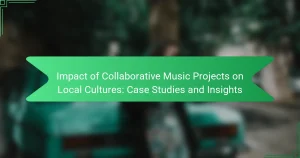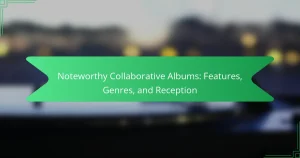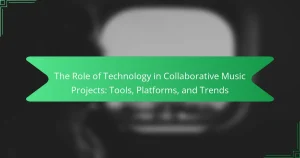Fusion music thrives on collaboration, blending diverse styles to create unique sounds that resonate worldwide. This article explores prominent collaborative artists like Ravi Shankar, Yo-Yo Ma, and Anoushka Shankar, highlighting their distinct styles and significant contributions. It also examines the impact of regional influences, the challenges faced in collaboration, and the evolving nature of fusion music through innovative partnerships.
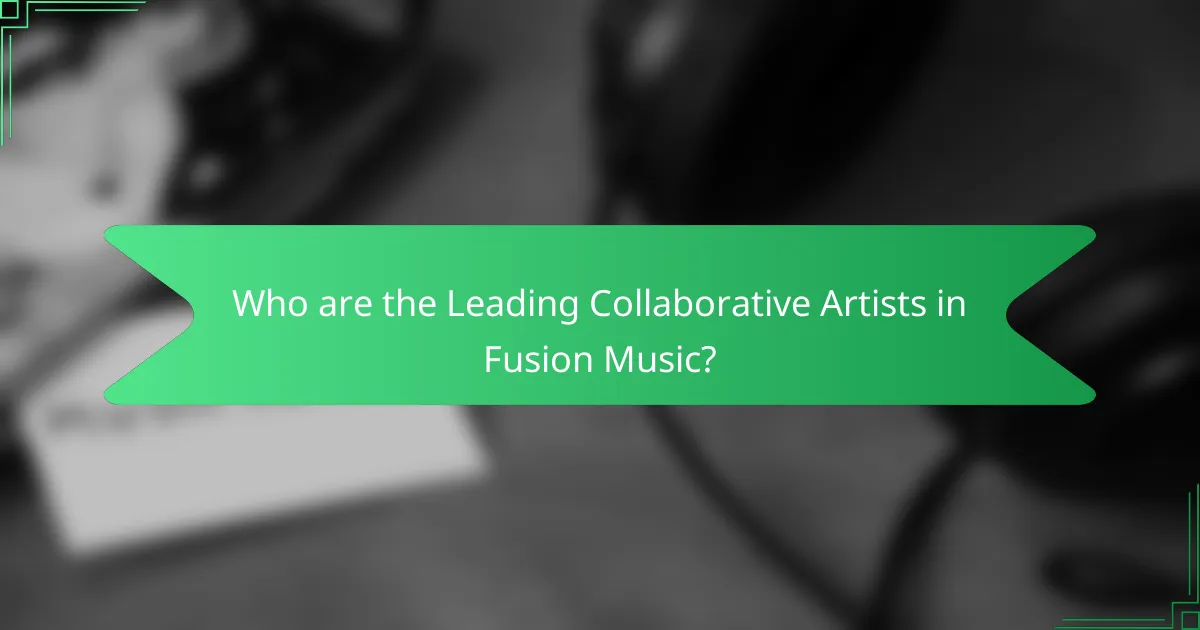
Who are the Leading Collaborative Artists in Fusion Music?
Prominent collaborative artists in fusion music include Ravi Shankar, Yo-Yo Ma, and Anoushka Shankar. These artists blend diverse musical styles, creating unique sounds that resonate globally.
Ravi Shankar is known for integrating Indian classical music with Western genres, enhancing cross-cultural appreciation. Yo-Yo Ma, a renowned cellist, collaborates across genres, emphasizing the emotional depth of fusion music. Anoushka Shankar, blending traditional Indian music with contemporary influences, showcases the evolution of fusion.
These artists contribute significantly to the genre, pushing boundaries and enriching the global music landscape. Their collaborations often result in innovative compositions that reflect cultural diversity and artistic synergy.
What are the Key Characteristics of Fusion Music Artists?
Fusion music artists are known for their diverse styles, innovative collaborations, and cultural blending. Key characteristics include versatility in genres, integration of traditional and contemporary elements, and a strong emphasis on improvisation. Many artists, such as Herbie Hancock and Anoushka Shankar, exemplify these traits through their unique contributions to the genre. Their ability to collaborate across musical boundaries enhances the richness of fusion music.
How do Collaborative Efforts Shape Fusion Music?
Collaborative efforts significantly enhance fusion music by blending diverse styles and cultural influences. Artists like Herbie Hancock, Chick Corea, and Ravi Shankar exemplify this synergy.
Herbie Hancock’s work in fusion incorporates jazz, rock, and electronic elements, creating innovative soundscapes. Chick Corea merges jazz with Latin influences, pushing genre boundaries. Ravi Shankar introduces Indian classical music, enriching fusion with intricate rhythms and melodies.
These collaborations foster creativity, leading to unique compositions that resonate with wider audiences. The blending of different musical traditions results in a rich tapestry of sound, showcasing the power of collaboration in shaping contemporary music.
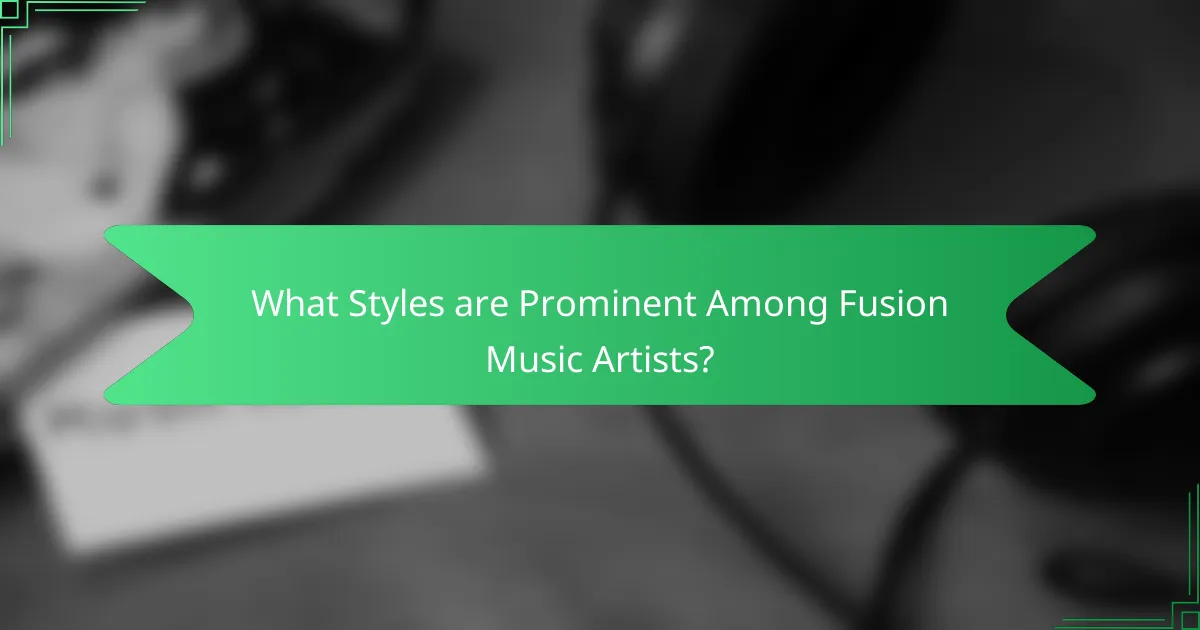
What Styles are Prominent Among Fusion Music Artists?
Fusion music artists often blend diverse styles, including jazz, rock, world music, and electronic genres. Notable contributions come from artists like Herbie Hancock, who infuses jazz with funk and electronic elements, and Shakti, which merges Indian classical with jazz improvisation. Additionally, artists such as Snarky Puppy and Jacob Collier exemplify modern fusion by integrating elements from various traditions and genres, creating a unique soundscape. These collaborations often highlight the versatility and innovation within fusion music, showcasing how different styles can coexist and enhance one another.
Which Genres Influence Fusion Music Collaborations?
Fusion music collaborations are influenced by diverse genres such as jazz, rock, electronic, world music, classical, and hip-hop. These genres contribute unique elements that enhance the collaborative sound. For instance, jazz brings improvisation, while electronic adds experimental beats. Rock often infuses energy, and world music introduces cultural rhythms. Classical provides complex structures, and hip-hop contributes lyrical depth. Together, these genres create a rich tapestry that defines fusion music.
How do Cultural Elements Impact Musical Styles?
Cultural elements significantly shape musical styles through collaboration, blending diverse influences. Prominent fusion artists like Yo-Yo Ma and Herbie Hancock exemplify this by integrating various genres and traditions. Their unique approaches enhance creativity, resulting in innovative soundscapes that reflect cultural diversity. For instance, Yo-Yo Ma’s Silkroad Ensemble merges Eastern and Western music, showcasing the impact of cultural exchange on artistic expression. As a result, fusion music evolves, enriching the global music landscape.
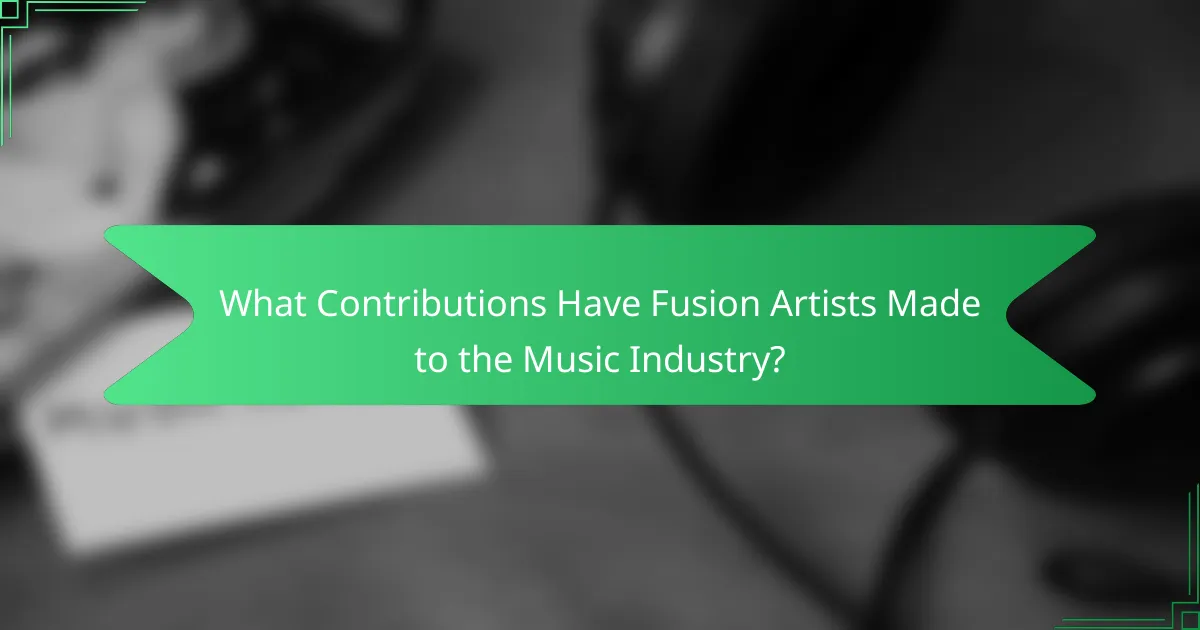
What Contributions Have Fusion Artists Made to the Music Industry?
Fusion artists have significantly enriched the music industry through innovative collaborations and genre-blending. These artists combine elements from various musical traditions, creating unique sounds that appeal to diverse audiences.
Notable contributions include the integration of jazz, rock, and world music, which has led to the emergence of new subgenres. For instance, artists like Herbie Hancock and Santana have fused electronic elements with traditional forms, pushing musical boundaries.
Additionally, fusion artists often collaborate across cultures, promoting global music exchange. This cross-pollination enhances creativity and broadens the reach of music, making it more inclusive.
The impact of fusion music extends to live performances, where artists often experiment with improvisation, creating dynamic and engaging experiences for audiences. This spontaneity keeps the genre fresh and relevant in a rapidly evolving music landscape.
How Have Collaborative Projects Changed the Landscape of Music?
Collaborative projects have significantly transformed the music landscape by blending diverse styles and fostering innovation. Prominent collaborative artists in fusion music, such as Herbie Hancock, Carlos Santana, and Erykah Badu, exemplify this shift. Their unique styles incorporate elements from various genres, enhancing creativity and broadening audiences. For instance, Herbie Hancock’s fusion of jazz with electronic music has set new standards in sound experimentation. Collaborative efforts often lead to groundbreaking albums that push artistic boundaries and redefine genres. This trend showcases the power of collaboration in enriching the musical experience and promoting cultural exchange.
What are Notable Achievements of Fusion Music Collaborators?
Prominent fusion music collaborators have achieved significant milestones in blending diverse musical styles. Notable artists like Herbie Hancock, Shakti, and Yo-Yo Ma have pushed creative boundaries, resulting in award-winning albums and innovative performances.
Herbie Hancock, a pioneer in jazz fusion, has won 14 Grammy Awards and introduced electronic elements to jazz. Shakti, featuring John McLaughlin, fused Indian classical music with jazz, creating a unique sound that has influenced many. Yo-Yo Ma, celebrated for his cello work, has collaborated with artists across genres, earning multiple Grammy Awards for his cross-genre projects.
These artists exemplify the impact of collaboration in fusion music, showcasing how diverse influences can lead to groundbreaking achievements.
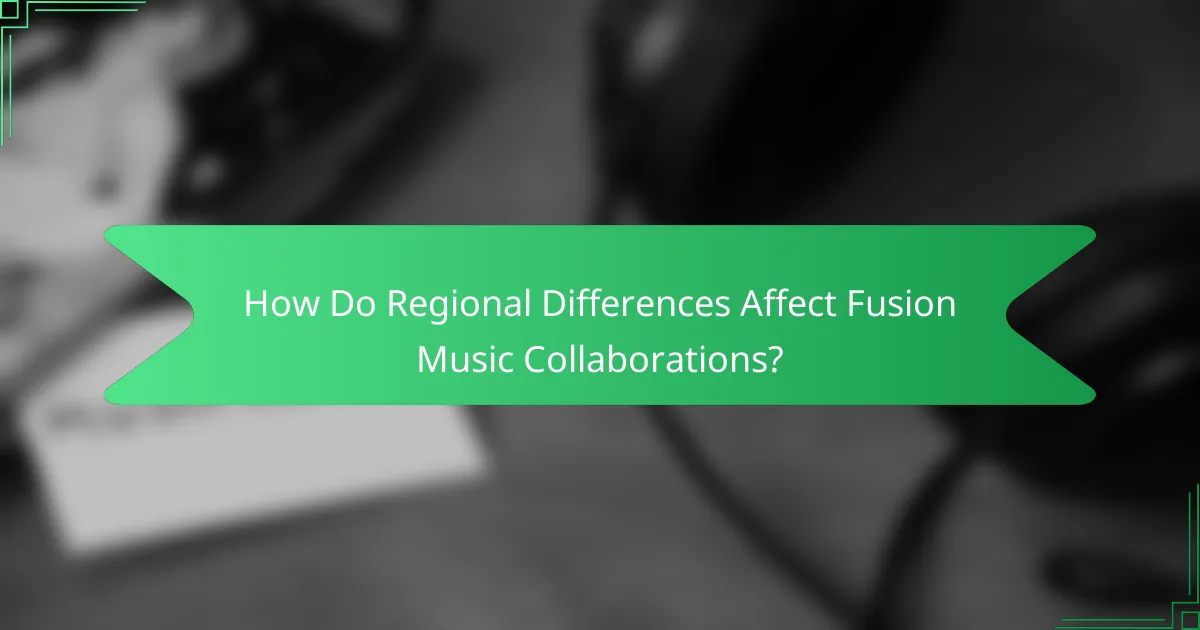
How Do Regional Differences Affect Fusion Music Collaborations?
Regional differences significantly shape fusion music collaborations by influencing artistic styles, cultural exchanges, and collaborative dynamics. Artists draw from local traditions, creating unique sounds that reflect their heritage. For instance, Indian classical musicians often blend their intricate rhythms with Western jazz, resulting in innovative compositions.
Cultural context affects collaboration; artists from diverse backgrounds bring distinct perspectives. This diversity fosters creativity, leading to unique fusion genres. Collaborations can also highlight social issues, bridging gaps between communities through music. Regional influences thus enhance the richness and variety of fusion music, making it a dynamic and evolving art form.
What Unique Collaborations Exist in Different Cultural Contexts?
Unique collaborations in fusion music reflect diverse cultural influences and innovative styles. Notable artists include Anoushka Shankar, who blends Indian classical with contemporary genres, and Yo-Yo Ma, known for his cross-genre cello performances. These collaborations enrich the music landscape by merging traditions and expanding audiences. Other prominent figures include the Afro-Cuban artist Pablo Milanés and the Brazilian musician Gilberto Gil, both of whom incorporate their cultural heritage into global music dialogues. Each artist’s unique style and contributions foster cultural exchange and artistic evolution within the fusion music scene.
How is Fusion Music Perceived in Various Markets?
Fusion music is perceived as a dynamic and innovative genre across various markets. Collaborative artists contribute unique styles and cultural influences, enhancing its appeal.
In North America, fusion music often blends jazz, rock, and world music elements. Artists like Herbie Hancock and Carlos Santana have shaped this landscape, attracting diverse audiences. In Europe, fusion incorporates electronic and folk influences, with artists like Anoushka Shankar pushing boundaries.
Asian markets view fusion music as a means of cultural exchange. Artists like A.R. Rahman combine traditional and contemporary sounds, appealing to both local and global listeners. In Africa, fusion often merges traditional rhythms with modern genres, as seen in the works of artists like Youssou N’Dour.
Overall, the perception of fusion music varies by region, shaped by the unique contributions of collaborative artists. Their distinct styles and cultural backgrounds enrich the genre, fostering a global appreciation for fusion music.
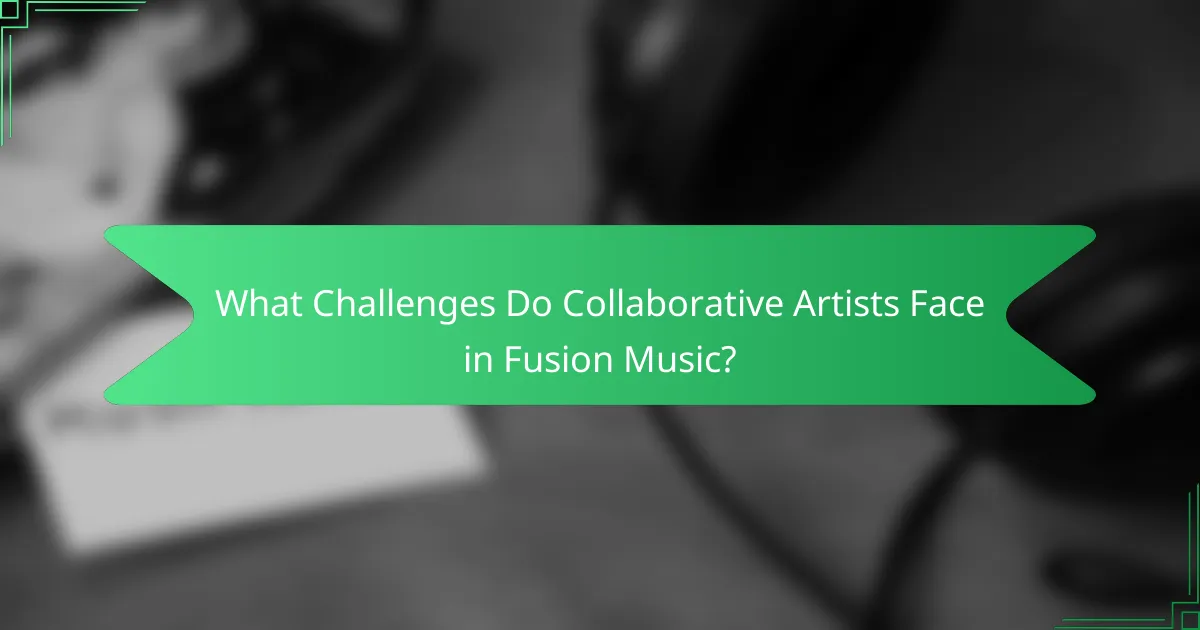
What Challenges Do Collaborative Artists Face in Fusion Music?
Collaborative artists in fusion music face challenges such as cultural differences, genre blending, and audience expectations. These factors can complicate creative processes and collaboration dynamics. Effective communication is essential to navigate these complexities. Additionally, balancing artistic integrity with commercial viability often poses a significant hurdle.
How Do Artists Navigate Creative Differences?
Artists navigate creative differences through open communication, flexibility, and a shared vision. Prominent collaborative artists in fusion music exemplify these strategies. They blend diverse musical styles while respecting individual contributions, fostering an environment where creativity thrives.
For instance, the collaboration of musicians from different genres often leads to innovative sounds. This approach allows them to merge unique attributes, such as traditional rhythms with modern influences, creating a rich auditory experience. The balance of distinct styles can enhance the overall impact of their work, showcasing the importance of collaboration in artistic expression.
In summary, successful navigation of creative differences hinges on mutual respect and a commitment to collaboration, enabling artists to produce groundbreaking fusion music together.
What Are Common Misconceptions About Fusion Music Collaborations?
Common misconceptions about fusion music collaborations include the belief that they lack authenticity and are merely commercial endeavors. Many assume that artists involved prioritize popularity over artistic expression. In reality, fusion music often emerges from genuine creative exchanges between diverse musical traditions. Collaborators frequently seek to innovate, blending styles to create unique sounds while respecting the roots of each genre. This artistic integrity often leads to groundbreaking work that challenges conventional boundaries.
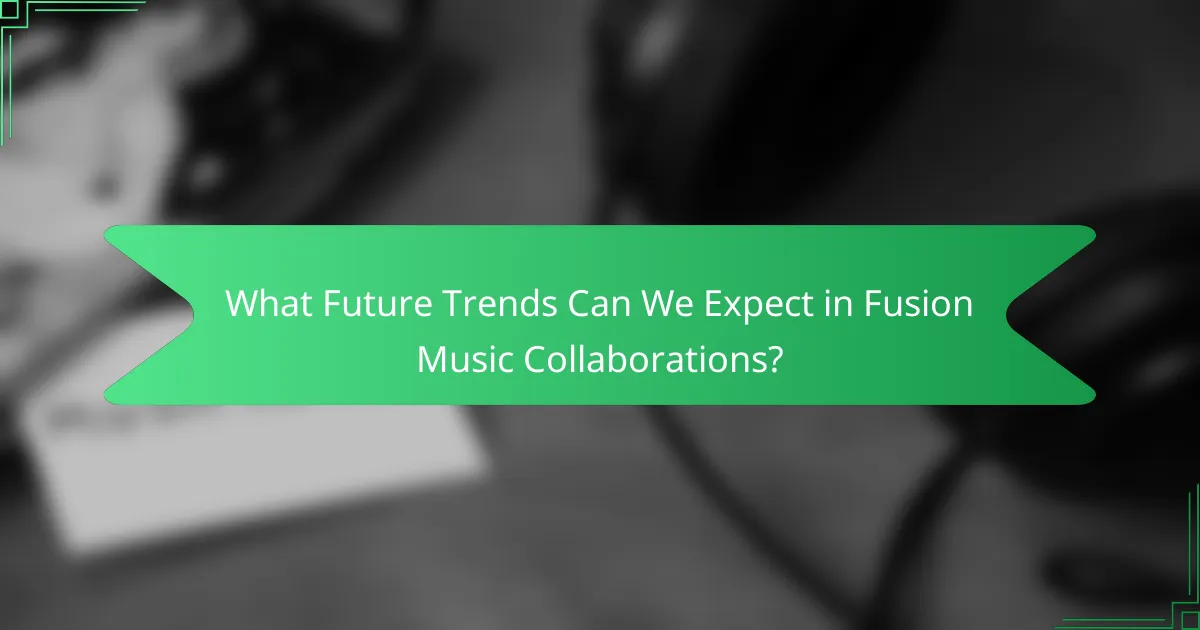
What Future Trends Can We Expect in Fusion Music Collaborations?
Fusion music collaborations are evolving with diverse influences and innovative styles. Artists are increasingly blending genres, creating unique sounds that reflect cultural diversity.
Prominent artists like Anoushka Shankar and Yo-Yo Ma exemplify this trend. Shankar merges classical Indian music with contemporary genres, while Ma blends classical with world music elements. This fusion enriches the musical landscape, attracting broader audiences.
Collaborative projects often feature cross-genre partnerships, enhancing creativity. For instance, collaborations between jazz musicians and electronic artists are gaining traction, showcasing experimental soundscapes. These partnerships are likely to redefine the boundaries of fusion music.
As technology advances, virtual collaborations are becoming more common. Artists can connect globally, leading to innovative projects that transcend geographical limitations. This trend is expected to shape the future of fusion music, fostering even more diverse collaborations.
Which Emerging Artists are Shaping the Future of Fusion Music?
Several emerging artists are significantly influencing fusion music, blending diverse genres and styles. Notable figures include Jacob Collier, known for his innovative harmonies and multi-instrumental talents, and Snarky Puppy, a collective that merges jazz, funk, and world music influences. Another key player is Hiatus Kaiyote, whose unique sound combines soul, electronic, and jazz elements. These artists contribute to the evolution of fusion music by experimenting with new sounds and collaborating across genres, thus shaping its future landscape.
How is Technology Influencing Collaborative Music Creation?
Technology significantly enhances collaborative music creation by enabling artists to connect and innovate across distances. Digital platforms allow musicians to share ideas, record remotely, and co-create in real-time. For example, software like Ableton Live supports live collaboration, fostering unique fusion styles. Additionally, social media platforms facilitate networking, allowing artists to experiment with diverse influences and reach broader audiences. This technological integration not only streamlines the creative process but also enriches the music landscape with varied contributions from prominent collaborative artists.
What Best Practices Should Artists Follow in Collaborative Projects?
Artists in collaborative projects should prioritize clear communication, mutual respect, and shared goals. Establishing roles early fosters accountability and creativity. Regular feedback sessions enhance the creative process and ensure alignment. Embracing diversity in styles can lead to innovative outcomes. Successful collaborations often reflect a blend of each artist’s unique attributes, enhancing the overall impact.
